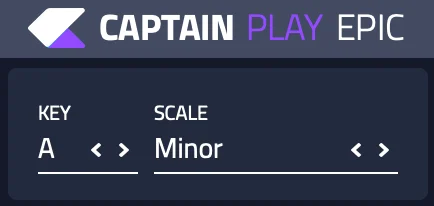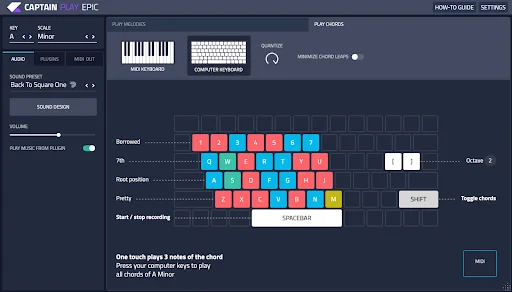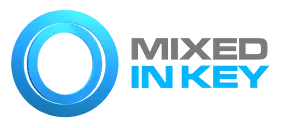How to: Captain Play Epic
Introduction
Captain Play Epic is a stripped down Captain Plugins Epic flavor. Its primary function is to let you play chords, melodies, basslines and more.

This is done in real-time and results in the creation of recorded MIDI regions that you can then add to your favorite instrument channels within your DAW.
You can choose to play on your computer keyboard, or MIDI keyboard, and all the notes will be locked to your chosen key and scale – you simply cannot play a bad note, unless you want to. We’ll go into accidental notes later in the tutorial.

Captain Play Epic can be added to your DAW on its own channel, using its own built in sound presets, or as a MIDI FX plugin to directly trigger your instruments (for DAWs that support MIDI FX).
If your DAW does not support MIDI FX then you can achieve the same result by using the MIDI OUT tab, or host your favorite instrument right inside Captain Play Epic by using the Plugins tab.

What you’ll learn
We’ll show you how to connect Captain Play in your DAW, choose if you want to write chords, or melodies (single note playback), quantise your MIDI recording, export to your DAW and/or save your recording as a MIDI file.
Let’s go!
- Start by setting a key and scale in the top left section of the user interface.

- To use Captain Play Epic using its own built-in sound presets, simply add it the same way you add any other Captain Plugins Epic flavor, or VST/AU/AAX instrument in your DAW.
- To use Captain Play Epic as a MIDI FX insert on an existing instrument track, look for the MIDI FX slot on your instrument’s channel.
- If you don’t have MIDI FX, then create a standalone instance of Captain Play Epic in your DAW, and then switch to the MIDI OUT tab. You’ll then see instructions on how to route Captain Play Epic to your chosen instrument.

- To host your 3rd party instruments within Captain Play Epic, add a standalone instance in your DAW and then click on the Plugins tab. You’ll see a list of plugin instruments which are compatible.
👀 TROUBLESHOOTING TIP
If you don’t see your instrument listed in the Plugins picker window, it may be that they are not compatible or have failed the validation check.
You can bypass this validation, if you wish, by holding down command (Mac) or control (Windows) and pressing Rescan.
If your instrument is still not shown, please ensure that it’s installed to one of the locations which Captain Plugins Epic scans (Windows only)
C:\Program Files\Steinberg\VSTPlugins
C:\Program Files\VSTPlugins
C:\Program Files\Common Files\VST2
C:\Program Files\Common Files\Steinberg\VST2
Chords or Melodies?
- Once you open Captain Play Epic, you’ll see the option to Play Chords or Play Melodies; and if you want to input the chords, or notes, via your Computer Keyboard or MIDI keyboard.

- If you want to play chords from your computer keyboard, select the Play Chords tab at the top and then the Computer Keyboard image. You’ll see the computer keyboard map with all the available chords for the key and scale you have chosen. The chord name is shown as you press each corresponding key.

- You can find alternative chords by holding Shift, or toggle the octave at which you will trigger by pressing the bracket keys [ ].

- Pressing your computer’s Spacebar will start playback of your DAW and the recording of the notes you play.
- If you want to play chords from your MIDI keyboard instead, select the MIDI Keyboard image and you’ll see a piano roll with all the available chords for the key and scale you have chosen.

- These are segmented and mapped in groups of an octave, one key will playback a 3 note chord, called a triad, for easy single-finger playing. This is helpful if you’re not trained in keyboard/piano playing.
⭐️ PRO TIP
You can add, or remove, octaves and choose from a list of predetermined groups of chords.
Mapping different zones on your MIDI keyboard gives you access to many different types of chords; and since you can choose the octave for each group, they can even be on the same octave as the next group, if you wish.
- Playing melodies works in much the same way, except you are triggering single notes, rather than chords.
- Use the Play Melodies tab for writing melodies, basslines, hooks, motifs, ARPs and anything else that isn’t a chord.

- When in computer keyboard mode, you can access various octaves from 1 to 5 from each row on the computer’s keyboard. E.g, octaves 2 and 3 are mapped to keys A to K.
- When in MIDI Keyboard mode, you can activate White-Key Mode which means all the notes within the chosen key and scale will be mapped to the white keys on your MIDI keyboard. This makes playing chord progressions or melodic lines even more simple.

- If you are using a MIDI keyboard, and you want to allow accidental notes – notes which are not part of your chosen key and scale – you can activate this option within the settings panel by unchecking the box shown below.

- When in the Play Chords tab, turn on the Minimize Chord Leaps option to ensure the chords play with the smallest amount of leap between each chord. Captain Play Epic will work out the best chord voicing to ensure the next chord you play transitions smoothly with the previous chord.
.

⭐️ PRO TIP
Chord leaps can be useful to create some excitement in a chord progression, but when overused they can make the chord progression sound disjointed.
- The Quantize function on both Play Chords and Play Melodies tabs allows you to determine how the chords or notes will be locked to the canvas. Click on the rotary knob to reveal more controls.


- The notes can be completely free for natural timing. Alternatively, if you want the notes to be snapped to a certain position, then choose a resolution from 1/8 to 1/32 and the notes will automatically snap to those positions as you record. You can also choose if the snapping should occur at the start of a note, the end, or both.
Export to your DAW
Once you’ve finished recording your chord progression or melody and you’re happy with the take, it’s time to add the MIDI recording to your DAW for further editing and integration to your song arrangement.
You can also save the MIDI recording as a MIDI file, if you prefer to work on it later – or simply save it as an idea.
- To export the MIDI recording to your DAW, drag and drop the recorded clip from the bottom right of the Captain Plugins Epic user interface straight onto a MIDI or Instrument channel in your DAW.

- The Captain Play Epic user interface will become transparent to make this action easier.
- If you prefer to save the MIDI recording as a MIDI file, press the cloud symbol with a downward arrow to open the Export MIDI to File pop up and save to a location of your choice.

- Clearing the MIDI recording is done automatically when stopping and restarting the recording by pressing the Spacebar. Alternatively, you can clear the recorded MIDI clip by pressing on the 3 dots next to the cloud symbol and select Clear.
That’s it for now, give it a try yourself and create some great chord progressions, melodies, basslines, hooks and motifs in real-time.


















